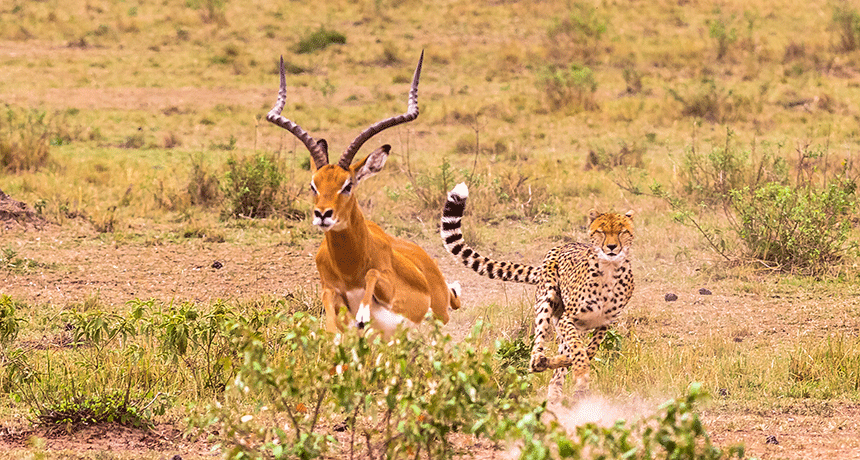Tricky turns give prey a chance against lions and cheetahs
A trove of data from the wild reveals secrets of a successful escape

Big cats like this cheetah may be faster than their prey. But life-and-death chases are about more than speed. Going slow enough for really sharp turns may give prey their best chance at getting away.
vlapaev/iStockphoto
By Susan Milius
Scientists have some advice for an impala suddenly rushed by a cheetah. Don’t just zoom off as fast as four hooves can carry you. The cheetah will catch you in a straight race. The best escape move is some fluky turn, even though it requires a slower stride. Swerve far enough, and the cheetah behind you will be racing too fast to make the same turn. That’s according to a new analysis of the most detailed chase data yet from big predatory cats.
Overall, cheetahs and lions are more athletic than the impalas and zebras they chase. However, prey still have a chance, says Alan Wilson. He studies biomechanics — how animals move. He works in Hatfield, England, at the Royal Veterinary College of the University of London.
Wilson’s group teamed up with researchers in the southern African nation of Botswana to collect motion data from wild animals. This included several hundred thousand strides from those animals. That let the researchers reconstruct the animals’ sprints and turns. “You’re actually doing a step-by-step dissection,” Wilson explains, “which is pretty cool.”
Wilson is a veterinarian and research scientist who says he’s “an equipment geek.” He began collecting data on cheetah chases in 2011. “Typically, your tracking collar will tell you where an animal is once an hour — or once every five minutes if you’re lucky,” he says. So Wilson and his colleagues designed new collars.
The new collars record data to calculate an animal’s position, speed and acceleration. And not just ever few minutes. These collars collect data multiple times a second. The collar falls off an animal after a certain time. Researchers can retrieve it. Then they can download data on the animal’s adventures.
Turn, zebra, turn
Wilson’s team collected collar data for two predator-prey groups in Botswana’s savannah. These were cheetahs and impalas, and lions and zebras. None of the collared cats were recorded chasing the collared prey. But the data let researchers compare more than 5,500 animal runs.
Each predator had advantages over its typical prey, the new study found. The cats ran about 38 percent faster. The predators also had about 37 percent faster acceleration. They could also slow down faster, with some 72 percent better deceleration.
While in Botswana, Wilson and his colleagues nipped tiny samples of muscle fiber from animals. They froze them in liquid nitrogen to take them back to England. In the lab, the researchers used those samples to measure muscle-contraction power. Both lions and cheetahs had about 20 percent more fiber power in a leg muscle than their prey did.
The researchers also wanted to see how an impala or zebra might escape the cats. They created stride-by-stride computer simulations of hypothetical pursuits. At top speeds, the prey had few options for veering to where a predator couldn’t pounce. The best hope came at slower speeds. That’s when the prey could pivot more to the side.
These computer results were backed up by the collar records. They showed a lot of running at moderate speeds by both predator and prey. The team shared its findings in the February 8 Nature.
The results of this research should help scientists better understand the ecosystem, Wilson says. “Your prey has to be fast enough to escape some of the time, but not all of the time. If you took lions and put them on a tropical island covered in sheep, they’d eat all the sheep. And then there’d be no lions.”
The detailed collar data allowed for a new level of analysis, says Paolo Domenici. He is a biomechanist, which means that he studies motion in living things. He works at the Institute for Coastal Marine Environment’s center near Oristano, Italy. Five or 10 years ago, he notes, measurements of animal athletics came mostly from treadmills or other lab setups. That kind of data is useful. But it doesn’t let scientists get a sense of animal moves in real-world chases.
This study “adds a major piece of the puzzle in the predator-prey arms races,” Domenici says. Now it would be interesting to study chases in places other than a relatively open savannah, he says.
Also, predators hunt in many more ways than just rapid pursuits, notes Talia Moore. She is a biomechanist at the University of Michigan in Ann Arbor. She has studied the unpredictable escape hops of little desert rodents called jerboas. She hopes the new paper will inspire more study of other types of hunting, such as ambushes.







